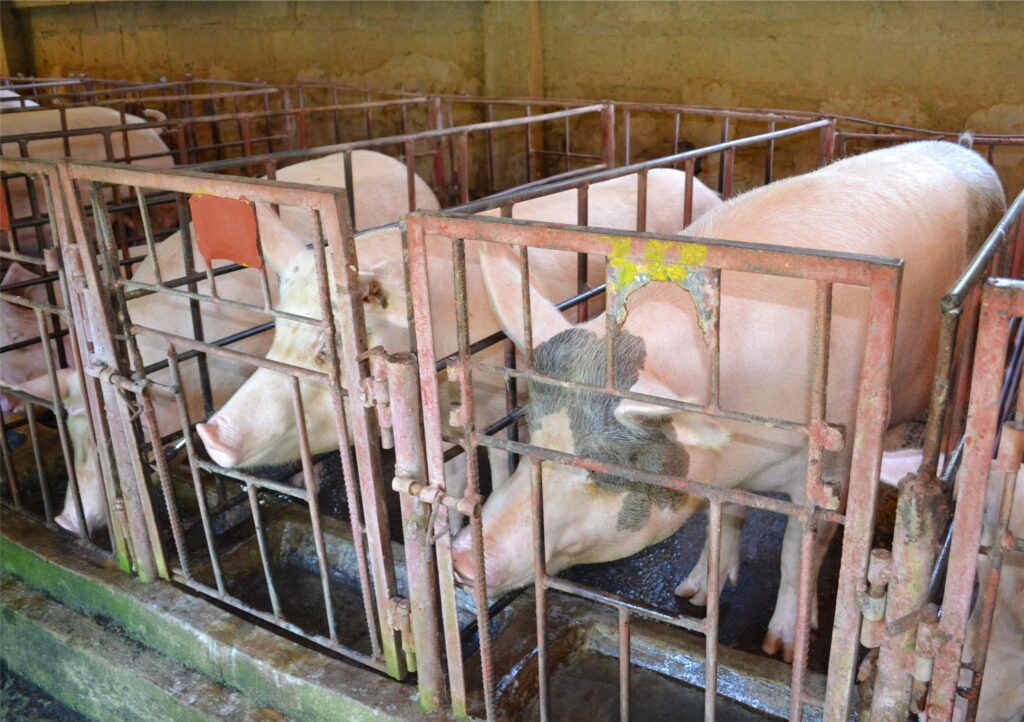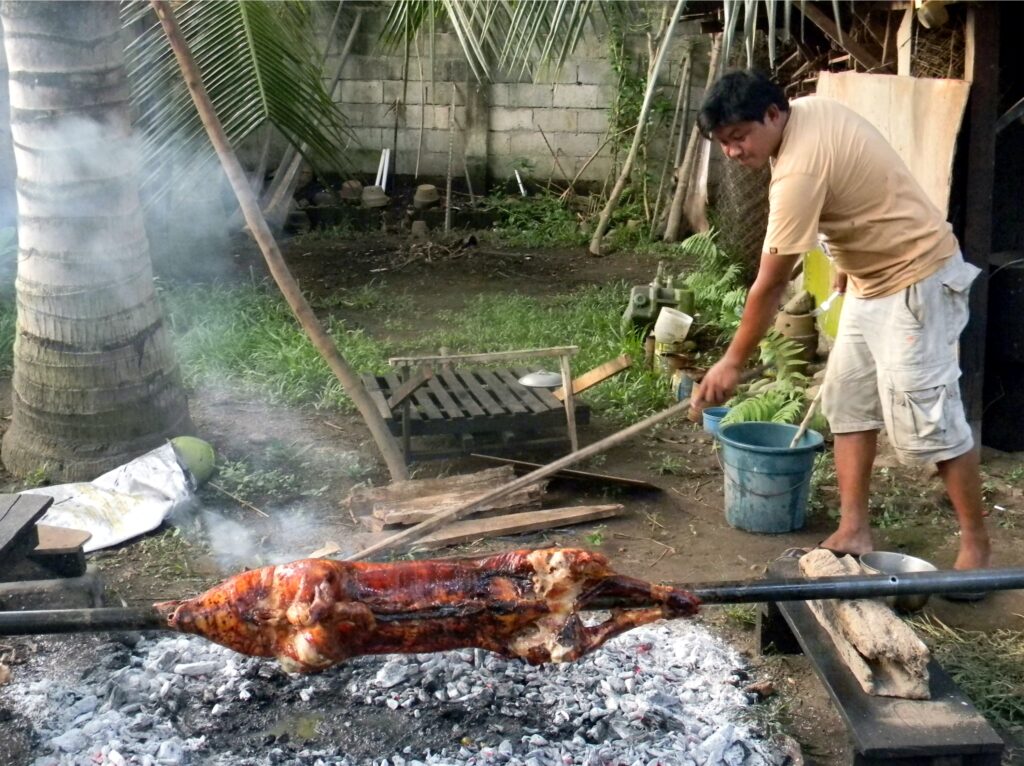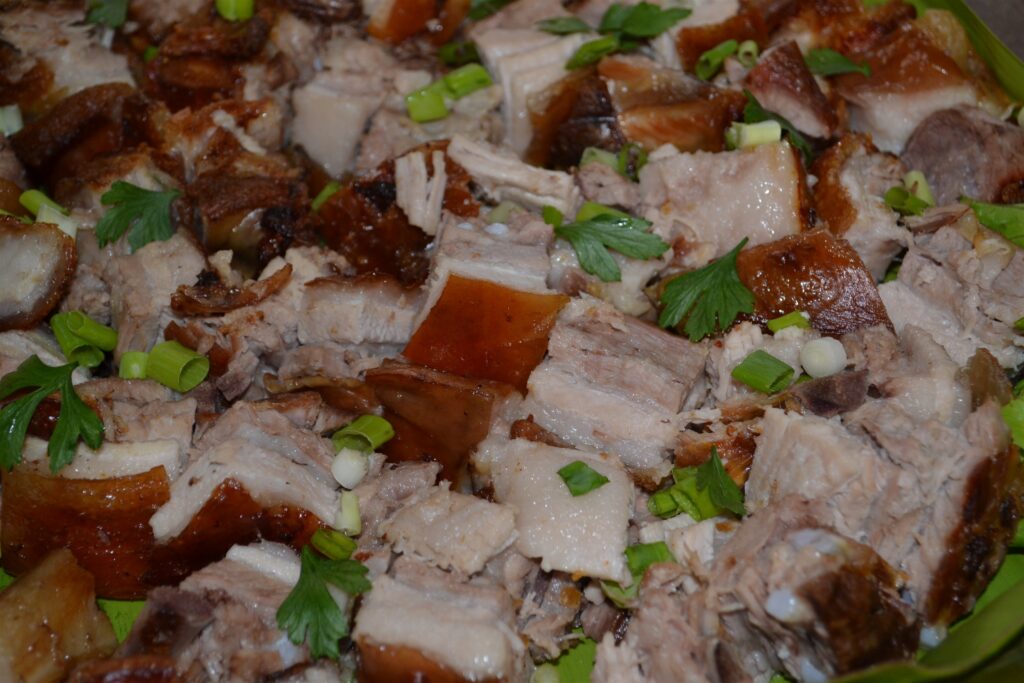Text and Photos by Henrylito D. Tacio
Swine raising is a P191-billion industry. Despite being almost exclusively without government subsidy, it is the second leading contributor to Philippine agriculture — after rice.
“The Philippine swine industry is ranked eighth in the world, in terms of the volume of pork production and number of breeding sows,” reports the Laguna-based Philippine Council for Agriculture, Aquatic and Natural Resources Research and Development (PCAARRD).
The Bureau of Agricultural Statistics showed the country’s swine inventory reached almost 12.00 million heads as of January 1, 2015. This was 1.68% higher than in 2014’s inventory of 11.80 million heads. Stocks in backyard farms went up by 1.64%. Likewise, stocks in commercial farms grew by 1.75% against the 2014 level. About 65% of the total stocks were raised in backyard farms, and 35% were in commercial farms.
Raising swine is very popular in various parts of the region because pork is the usual meat served during occasions like birthdays, weddings, anniversaries, and other celebrations. During town fiestas, people expect nearly every household to have “lechon” (roasted pig) on their dining tables.
Swine can be sold alive at a livestock market or processed into pork for home use at a local livestock slaughtering facility. The most important products are hams, chops, bacon, and sausage.
Most swine raised in the country are native breeds fed mostly with rice bran and kitchen wastes. They attain 70-80 kilogram body weight in 315 to 405 days and need about 6-7 kilograms of feed to gain a kilogram live weight.

Sow and piglets 
Pigs
These days, it takes only about six months to raise a pig to a weight of about 90 kilograms. Modern breeds of pigs grow fast, weigh heavier, produce more piglets, and have better meat.
But “despite being dynamic and technologically advanced, the local pig industry is still confronted with inefficiency of production due to low sow productivity,” notes PCAARRD, a line agency of the Department of Science and Technology (DOST). Because of this, it supported research and development initiatives to improve the productivity of the Philippine swine industry.
In other swine-producing countries, the application of gene markers that are associated with economically important traits has resulted in significant improvement in the number of pigs produced and consequently the hog live weight produced per sow per year.
In the Philippines, the application of gene markers was developed by the Philippine Carabao Center (PCC) and Bureau of Animal Industry (BAI) in partnership with the Accredited Swine Breeders Association of the Philippines (ASBAP). So far, 16 gene marker protocols associated with large litter size, fast growth rate, and meat qualities, as well as seven markers for screening of genetic defects and disease resistance, were optimized.
“The adoption of the gene marker technology by the swine breeder farms is expected to increase productivity and efficiency in terms of number of pigs weaned and live weight produced per sow per year,” the PCAARRD says in a press statement.
Until these breeds are available, farmers who raise swine in their farms should consider the following when buying breeder sows. According to the Mindanao Baptist Rural Life Center (MBRLC), they should have from 12-14 well-spaced teats, prominent teats. Those with inverted teats — an inherited trait — should be avoided as such teats do not secrete milk.
“Select those with a uniform body width and depth, a good underline, and a smooth face with clean-cut jowls and bright eyes,” suggests Roy C. Alimoane, the MBRLC director who is an animal scientist. Female breeders should come from a litter of 8 or more good-sized piglets, he adds.
Since pigs are easily affected by cold and heat, they should be provided a house that protects them from intense heat and chilling rain. The Davao-based MBRLC gives the following guidelines:
· Construct the pig house on a slightly sloping and well-drained area so that it will not become too muddy and inconvenient.
· As far as possible, use cheap and locally available materials such as bamboo, nipa, or palm fronds. Use building materials that will provide the optimum environmental temperatures and adapt the house to the conditions in your locality.
· If you are planning to build a permanent house, cement the floor to make the cleaning easier and to minimize the presence of parasites and diseases.
· A 9 x 10 feet pig pen can accommodate one sow and her piglets or 10-20 growing pigs or 6-8 fattening pigs. The walls separating the pens should be about 3 feet high for convenience in doing your work.
· Provide the pig house with the proper equipment such as feeders, drinking troughs, and other facilities. Feeders and water troughs are best made of concrete, although other materials may be used. Be sure the water is fresh and clean.
· Facilities such as heat lamps or brooders are needed to keep new-born pigs warm. In places where the use of heat lamps is not possible, a box lined with old sacks or thickly bedded with rice straw, rice hull, or sawdust can keep the pigs warm and comfortable, especially in a cold and damp environment.
Most gilts of the improved breed reach the age of puberty at about 6-8 months of age, but they should not be bred until they are eight months of age or are weighing about 90-100 kilograms.
“Mating should be carried out in the morning on the second or third day of heat,” Alimoane suggests. “The sow can be mated in the morning and maybe a second time the following day.”
On the average, a sow will farrow in 114 days after a successful mating. The usual range is 109-119 days. Watch for the following signs: the sow becomes restless and nervous, the abdomen swells, the vulva is swollen with possible mucus discharge, and milk is present in the teats if pressed.
According to MBRLC, when the sow is placed in the farrowing pen, the amount of feed is reduced gradually by one-fourth to one-half. Light laxative feed such as rice bran or copra meal is given. These ingredients may make up as much as one-half of the ration.
“Don’t change the feed abruptly,” Alimoane suggests. “Regulate feeding. Don’t feed the sow in a self-feeder where it can eat all the feed it wants. Too much feed causes caked udder or mastitis.”
Alimoane also suggests that raisers should be present in the pen during actual farrowing, but he should not disturb the sow unless she has difficulty in delivering her piglets. Farrowing may take as long as 24 hours or as short as 5-6 hours.
When the sow has given birth, “don’t feed her for 24 hours,” Alimoane says. “Just supply enough water during this period. Give a little feed on the second day and increase it gradually until the full ration is reached.”
About one to two piglets in every litter crop die at farrowing time. The reason: the mother swine is not given proper care and attention when it gives birth. The farrowing season covers the period one week before and one week after the mother swine gives birth. Fewer piglets will die at this time if more attention is paid to them.
Here are more tips from MBRLC in taking care of swine:
Two to 4 weeks after birth, the young male piglets, which are not selected for breeding purposes, are castrated. Castration is done to speed up the animals’ growth, which will be fattened for the market.
The piglets are weaned when they are about eight weeks old. In weaning, it is best to take the sow away entirely out of sight and hearing.
Keep the hogs clean at all times. Strict sanitation and cleanliness produce disease-free and healthy pigs.
The pen should be washed with clean water every day and regularly disinfected with reliable disinfectant. If a pig or piglet is sick, it should be isolated immediately. The pen should be left vacant for 3-5 days before housing other piglets or pigs in it.
The common diseases of pigs are hog cholera, anemia, pneumonia, diarrhea, parasites, and swine plague. Contact your BAI technician in your area or the local veterinarian to let you know how to detect, control, and prevent these diseases.
Marketing is the last job done on growing-finishing pigs. Hogs are marketed when they reach at least 80 kilograms. Marketable hogs may be sold to middlemen who usually act as buying or selling agents or directly to meat processors. They may also be marketed in auction markets where animals are sold to the buyer, who offers the highest acceptable price per kilo live weight or per head.
Meanwhile, most farmers in rural areas prefer raising the native breed. Characteristically small, usually black in color, spotted, and are resistant to parasites and diseases, native pigs can adapt to local conditions and can tolerate heat and cold environments better than the imported breeds. They can thrive well on locally available feeds, including kitchen and farm refuse, and can cope with low-quality feeds and maintenance.
According to the Bureau of Agricultural Research (BAR), a native pig project could raise good periodic income for farmers in just selling piglets and opens bigger opportunities for them to sell the specialty “lechon.”
“A farmer with two sows, each producing seven weanlings three times in two years, will have added income of P33,700 from piglet sales alone,” said Dr. Mary Jean Bulatao, the Native Swine Project team leader of the University of the Philippines at Los Baños (UPLB).



